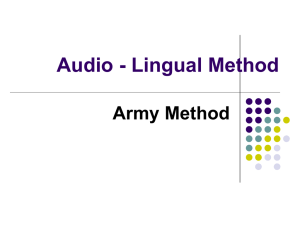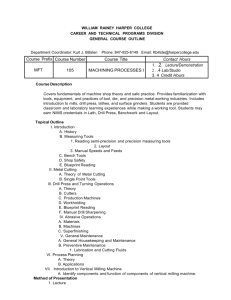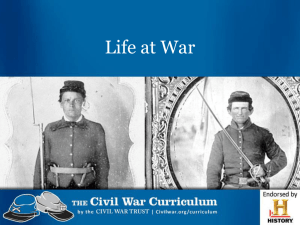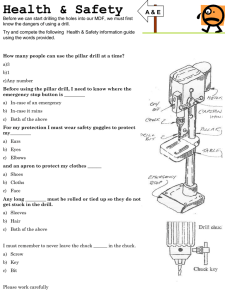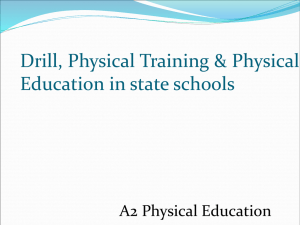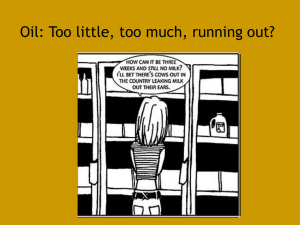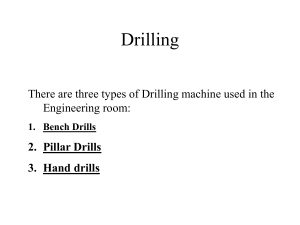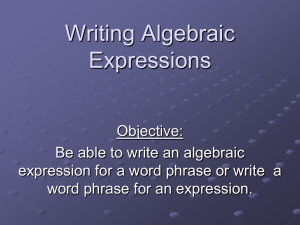File
advertisement
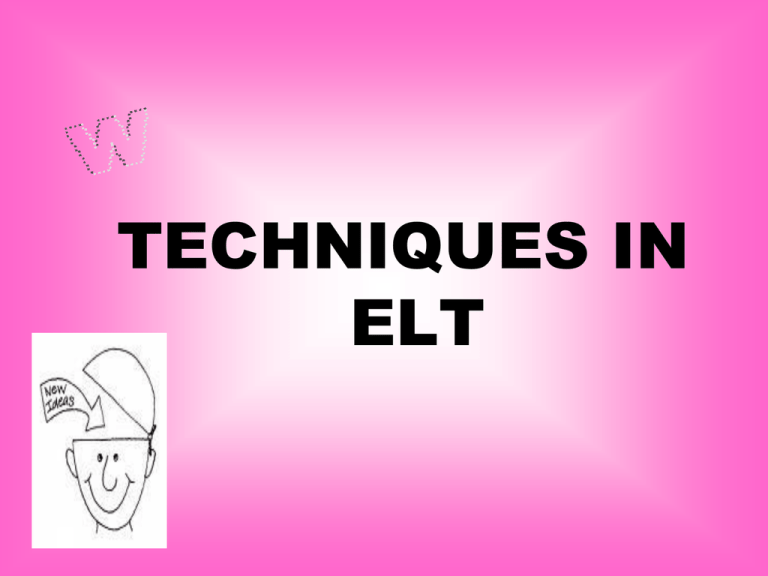
TECHNIQUES IN ELT CONTENT 1- What is technique? 2- Why do teachers need to use technique? 3- Kinds of techniques? 4- Techniques in all approaches and methods. 5- Summary. What is technique? Technique: (implementations) The level at which classroom procedures are described. Edward Anthony Why do teachers need techniques in the classroom? Techniques; ►tool for teaching. ►promote the success of students. Kinds of Techniques 1- Controlled techniques 2- Semi-controlled techniques 3- Free techniques 1- Controlled techniques: Drills, dialogues, reading aloud, display questions/answers… 2- Semi-controlled techniques: Information gap activities, cued narratives, referential questions/answers… 3- Free techniques: Role plays, debates, problem solving, interview, discussions… GRAMMAR TRANSLATION METHOD(GTM) TECHNIQUES: ●Translation ● Reading comprehensible questions ● Antonyms/Synonyms ● Cognates ● Fill in the blanks ● Memorization ● Use words in sentences ● Composition ●Deductive application of rule Cognates Similar spelling and sound patterns that correspond in L1 and L2. E.g: Method / Metod Modern / Modern Of course; This technique would only be useful in languages that share cognates. Fill in the Blanks Example: ● We …….got many books. ● There……a vase on the table. Use Words in Sentences ►I could not recognize him after so many years. DIRECT METHOD ● Reading aloud ● Question/answer exercise ● Getting students to self-correct ● Conversation practice ● Fill in the blank exercise ● Dictation ● Map drawing ● Paragraph writing Dictation The teacher reads the passage 3 times; 1- at a normal speed. 2- phrase by phrase. 3- again at a normal speed. Map Drawing It is used for listening comprehension practice. The students are asked to write the names of the cities on the map. Paragraph Writing ● Students write paragraphs in their own words using the target language. AUDIOLINGUAL METHOD ● Dialogue memorization ● Backward build-up drill ● Repetition drill ● Chain drill ● Single-slot substitution drill ● Multiple-slot substitution drill ● Transformation drill ● Question/answer drill ● Use of minimal pairs ● Complete the dialogue ● Grammar game Repetition Drill T: This is a pencil. (repeat after me) S: This is a pencil. Chain Drill T: How are you? S: Fine, thanks. How are you? (to the student near him/her) Another student: Fine, thanks…. ► The activity goes on in this way. Single-slot Substitution Drill E.g: T: Ali went to the zoo. T: Zoo (cue word). S: Ali went to the zoo. Multiple-slot Substitution Drill Cue phrases T: Ali has got an apple and Ayşe has got a banana. T: Has got S: Ali has got an apple and Ayşe has got a banana. Transformation Drill First; Teacher gives the positive form of a sentence. Then; Asks for the negative form of it. Question/Answer Drill T: S: T: S: What is this? This is a pencil. What are these? These are books. ►Students reply very quickly. Minimal Pairs E.g: - Expert/export - Firm/form - Vest/vast Complete the Dialogue A: B: A: B: Where …… you going? I ….. going to the market. Can ..... buy a chocolate for me? Yes, I …… . Grammar Game It helps students in thinking and communicating not just drilling. ORAL APPROACH and SLT ● Imitation ● Drills ● Question/answer Imitation 1- Chorus imitation. 2- Individual imitation. TOTAL PHYSICAL RESPONSE ● Using commands ● Role reversal ● Action sequence Action Sequence Commands related to each other. - Take out a pen. - Seal the envelope. - Take out a piece of paper. - Write the address on the envelope. SILENT WAY ● Sound-color chart ● Teacher’s silence ● Peer correction ● Rods ● Self-correction gestures ● Word-chart ● Fidel chart ●Structured feedback Self Correction Gestures The teacher uses his palms as a tool while showing the students’ mistakes. Word Chart First; Teacher points to words on the charts. Then; Students read them aloud. Fidel Chart The aim: Associating the sounds of the language with their spelling. COMMUNITY LANGUAGE LEARNING (CLL) ● Translation ● Group work ● Recording ● Transcription ● Analysis ● Reflection and observation ● Listening ● Free conversation SUGGESTOPEDIA ● Imitation ● Question/answer ● Role play ● Dialogues ● Translation Dialogues Students learn the target language through the dialogues. Example: Target language: Native language: Jane: Would you like to have a cup of tea? Sally: No, thanks. Jane: Bir fincan çay ister misiniz? Sally: Hayır, teşekkürler. WHOLE LANGUAGE ● Ungraded dialogue journals ● Individual/small group reading/writing ● Writing portfolios ● Writing conferences ● Student-made books ● Story writing Ungraded Dialogue Journals Forms of writing: _ spontaneous _ personal _ informal _ comfortable _ ungraded _ unedited MULTIPLE INTELLIGENCES ● Multisensory activities & ● Use of realia NEUROLINGUISTIC PROGRAMMING (NLP) ● Rapport: Working within the students’ framework, not against them. THE LEXICAL APPROACH ● Collocations of vocabulary teaching activities V+N: take a vacation Adj+N: light rain Adv+V: completely forget Longer Collocation I will give you a call. Competency-based Language Teaching (CBLT) ● Social life activities E.g: Retaining a job. COMMUNICATIVE LANGUAGE TEACHING (CLT) ● Role plays & ● Simulations Simulations ● Roles ● Creating a rich communicative environment Example: Convergent model Divergent model “This is the “This is the problem. How shall situation. What will we solve it?” we do?” NATURAL APPROACH (NA) ● Command ● Mime, gesture ● Question/answer ● Group-work activities Command First; Simple commands. E.g: Stand up! Turn round! Then; Complex ones. E.g: Pick up a pencil and put it under the book. COOPERATIVE LANGUAGE LEARNING (CLL) ● Three-step interview ● Roundtable/Round Robin ● Think-pair-share ● Solve-pair-share ● Numbered heads Roundtable/Round Robin 3 steps: 1- One student makes a contribution. 2- He/she passes the paper and pen to another student. 3- Each student makes a contribution in turn. ♣ If done orally, it is called Round Robin. Solve-Pair-Share 1- Teacher poses a problem. 2- Students work out solutions individually. 3- They explain how they solved the problem to the classroom. CONTENT-BASED INSTRUCTION (CBI) ● Vocabulary building ● Discourse organization ● Communicative interaction ● Language skills improvement ● Study skills Discourse Organization ►Language is taught through texts chosen according to students’ needs, interests, abilities. E.g: Letters Essays Descriptions Reports Meetings Lectures Discussions TASK-BASED LANGUAGE TEACHING (TBLT) ● Jigsaw tasks ● Information gap tasks ● Problem solving tasks ● Decision making tasks ● Opinion exchange tasks Jigsaw Tasks This involves learners combining different pieces of information to form a whole. Information Gap Tasks 1- There are two groups; 2- They negotiate and find out what the other group’s information is. 3- They complete the activity in this way. Problem-solving tasks 1- A problem and a set of information is given. 2- A solution is needed. Result: A single resolution. Decision Making Tasks ● A problem with many possible solutions. ● Students choose one of them through discussion. Opinion Exchange Tasks ● Students discuss. ● They do not have to reach an agreement. We cannot think of a teaching/learning process without using technique. Whether it is teacher or student-centered. THANKS
